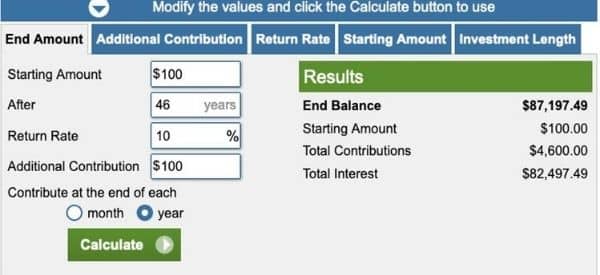Compound Interest: How to Grow your Wealth
Categories: Finance
Thank you Black Swan Capital for helping us understand compound interest and how to make smart investments!
Many of us are constantly considering different ways to earn more money and reach financial independence. You may want to start your own business, teach a skill set online, or even learn a new one in order to expand your options.
One of the more obvious ways to increase your wealth is by benefiting from the power of compound interest through investing. That is, by investing in assets or accounts which have the opportunity to earn compound interest over time. Remember, though, that investments come with risk, and it’s important to speak to a licensed financial advisor to see if (and what kind of) investing is right for you.
Where to Start?
The first thing to do is understand why you’re investing. That is to have a goal in mind. A goal is something personal to you. Examples of goals include saving for retirement, making a down payment on a house, or starting a business in the future. It’s deeply personal. Once you’ve defined your goal, there are two things to keep in mind to help you achieve it:
- Adding to your investments on a regular basis can have a large impact over time.
- Compound interest: Simply put, interest (or a return) on your interest. So, if you are reinvesting your dividends and achieving capital growth over time, your asset will grow progressively (and exponentially) faster.
Remember, like any other goal, such as exercising, small actions done consistently over time can have a substantial impact. Here again, a financial advisor can guide you through the steps to reach your financial goals.

How Does Compound Interest Work?
In short, it means that the interest on your investment earns interest or a return. This return is often expressed on a yearly basis as a percentage.
When you invest in a certain type of account, such as savings, for instance, the principal sum should accrue interest. If the rate only applies to the principle, it’s considered a simple interest. If the rate applies to the principal plus the interest previously accrued in the previous year, it’s called compound interest or compound return.
An Example with Numbers from a Compound Interest Calculator
The example below explains how compound interest works.
Let’s say, you make an investment of €100, with an annual interest rate of 10 percent. At the end of the first year, your account has €110 (1.10 interest rate x €100).
The next year, you earn interest on your original €100 (the principal) plus the €10 you previously received as interest. So, this means at the end of your second year your account has €121 (1.10 interest rate x €110).
While in this example the interest rate doesn’t change, the amount you earn from the interest increases every year. In other words, the interest grows on top of itself, which means you earn more money every period.
After about 46 years, that €100 investment could grow to €8,019. But keep in mind that a 10 percent interest rate is extremely rare. And many personal bank accounts nowadays don’t offer interest rates at all. The above is an example to illustrate the idea. Although it illustrates compound interest based on a bank account, when it comes to investing the interest or returns one would typically receive is usually in the form of:
- Capital Gains
- Dividends
- Coupons
- Interest on cash or short-term investments
All the items above, when aggregated together, provide you with an overall rate of return (interest) of/on your portfolio. Keep in mind that this return (or interest) will generally fluctuate on a yearly basis, and don’t be fooled as it can also be negative!
Try a Compound Interest Calculator for Some Numbers Fun!
If you’d like to try a few data-based scenarios to see how compound interest works, consider having fun with a compound interest calculator. There are quite a few of them online, but here is one that is quite popular from calculator.net.
The way it works is simple: enter a starting amount, the interest rate you would like to try, the number of years, and any additional contributions (and how often). Hit calculate and let it do its magic. Keep in mind that this calculator is for educational purposes only, not to be used as an investment guide or for advice. In order to get more info about actually investing, make sure to consult a licensed financial advisor.
What Do you Do When Interest Rates are Low?
When interest rates at the bank are low, it’s important that investors consider returns elsewhere to reach their financial goals. As mentioned earlier, by contributing to your investment, on a regular basis one does have the opportunity to reach their financial goals sooner and also helps average out fluctuations in the markets over time: a phenomenon known as cost averaging.
If we take the example previously illustrated, with a contribution of €100 per year (assuming a fixed interest rate of 10% per year) the hypothetical result achieved is as follows: €82.198, that’s 10 times the previous example. (See table below)

Figure 1: https://www.calculator.net/
Re-Investment versus Income: How Should I Spend My Returns?
Once you’ve setup an investment account with a licensed financial advisor, they, as part of your investment strategy, should have explained to you the following:
As you earn interest or returns there are two options:
- Reinvesting the returns back into the investment account or fund.
- Take the dividends, interest, or returns out as a form of passive income.
Ultimately, the decision to do either should be in line with the investment goals and strategy laid out with your financial advisor.
Reinvestment
Certain investment accounts or funds (basket of stocks) will automatically reinvest (the advisor generally does that) dividends or returns into the fund or account for you. With compound interest, that reinvested money can further assist with reaching your financial goals. Additionally, if you keep contributing to your investment, the compound interest will continue to aggregate. Even if you only make small deposits, they can increase the value of your portfolio over time. Remember it’s all about consistency.
Income
Alternatively, if you want additional income in the short term, you can transfer the dividends or returns to your bank account. For example, you buy a house and rent it out. You might use that rent payment (the dividend) to cover property maintenance or other household costs. Generally speaking, those who have retired will more likely opt for passive income rather than re-investing as they have had the time to reach their goals and plan for retirement.
At the end of the day, if you want that passive income to earn more passive income, you should invest the dividend. “Most investments have the potential for compounded interest growth,” says David from Black Swan Capital.
Always Remember
With all investments, there is no guarantee of earnings. The market will always fluctuate, as we’ve seen in recent years. But making long-term investments and leveraging compound interest can help ease your financial burdens by distributing risk and earnings over the course of years.

Make Your Money Work for You
If you have a large sum of money (in addition to your rainy-day fund) and have an income, compound interest can help your wealth grow and reach your financial goals. For more advice on how to invest your money as an expat in the Netherlands, contact Black Swan Capital.
